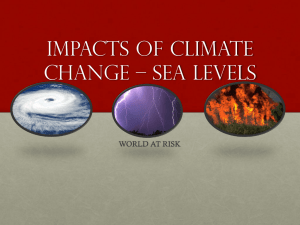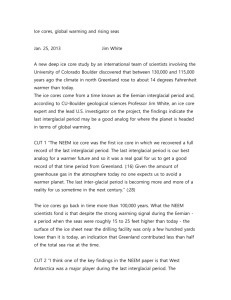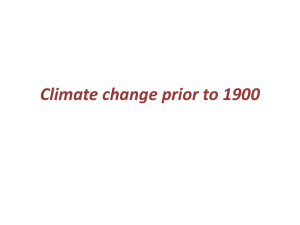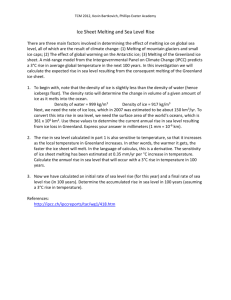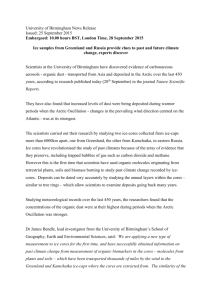younger glacial
advertisement
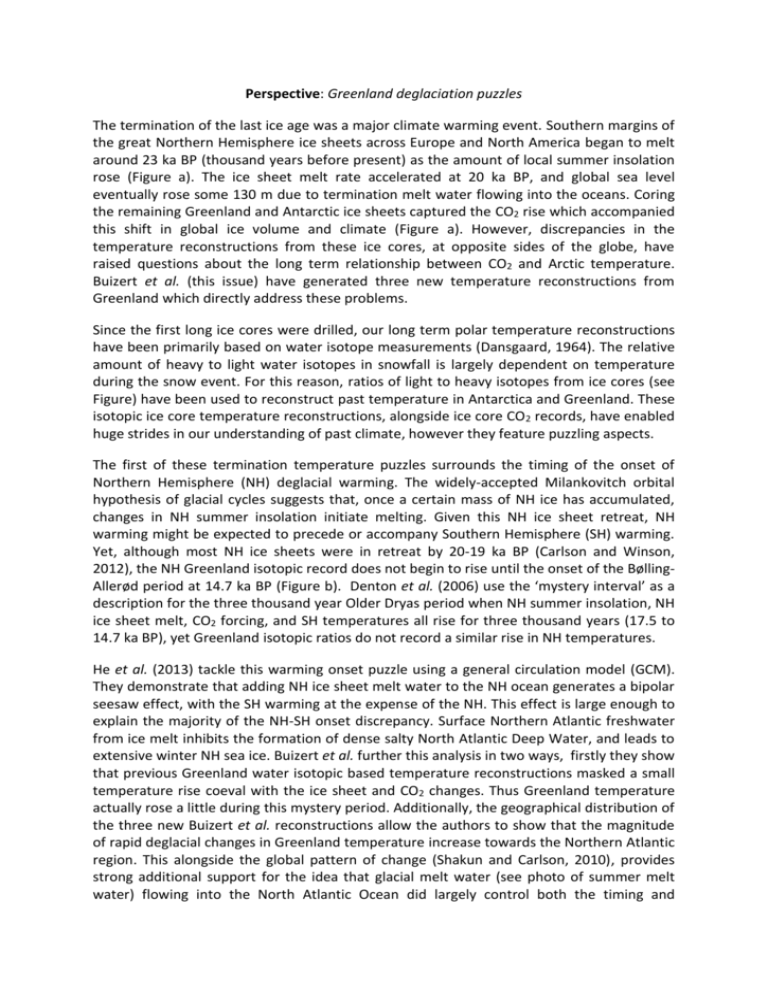
Perspective: Greenland deglaciation puzzles The termination of the last ice age was a major climate warming event. Southern margins of the great Northern Hemisphere ice sheets across Europe and North America began to melt around 23 ka BP (thousand years before present) as the amount of local summer insolation rose (Figure a). The ice sheet melt rate accelerated at 20 ka BP, and global sea level eventually rose some 130 m due to termination melt water flowing into the oceans. Coring the remaining Greenland and Antarctic ice sheets captured the CO2 rise which accompanied this shift in global ice volume and climate (Figure a). However, discrepancies in the temperature reconstructions from these ice cores, at opposite sides of the globe, have raised questions about the long term relationship between CO2 and Arctic temperature. Buizert et al. (this issue) have generated three new temperature reconstructions from Greenland which directly address these problems. Since the first long ice cores were drilled, our long term polar temperature reconstructions have been primarily based on water isotope measurements (Dansgaard, 1964). The relative amount of heavy to light water isotopes in snowfall is largely dependent on temperature during the snow event. For this reason, ratios of light to heavy isotopes from ice cores (see Figure) have been used to reconstruct past temperature in Antarctica and Greenland. These isotopic ice core temperature reconstructions, alongside ice core CO2 records, have enabled huge strides in our understanding of past climate, however they feature puzzling aspects. The first of these termination temperature puzzles surrounds the timing of the onset of Northern Hemisphere (NH) deglacial warming. The widely-accepted Milankovitch orbital hypothesis of glacial cycles suggests that, once a certain mass of NH ice has accumulated, changes in NH summer insolation initiate melting. Given this NH ice sheet retreat, NH warming might be expected to precede or accompany Southern Hemisphere (SH) warming. Yet, although most NH ice sheets were in retreat by 20-19 ka BP (Carlson and Winson, 2012), the NH Greenland isotopic record does not begin to rise until the onset of the BøllingAllerød period at 14.7 ka BP (Figure b). Denton et al. (2006) use the ‘mystery interval’ as a description for the three thousand year Older Dryas period when NH summer insolation, NH ice sheet melt, CO2 forcing, and SH temperatures all rise for three thousand years (17.5 to 14.7 ka BP), yet Greenland isotopic ratios do not record a similar rise in NH temperatures. He et al. (2013) tackle this warming onset puzzle using a general circulation model (GCM). They demonstrate that adding NH ice sheet melt water to the NH ocean generates a bipolar seesaw effect, with the SH warming at the expense of the NH. This effect is large enough to explain the majority of the NH-SH onset discrepancy. Surface Northern Atlantic freshwater from ice melt inhibits the formation of dense salty North Atlantic Deep Water, and leads to extensive winter NH sea ice. Buizert et al. further this analysis in two ways, firstly they show that previous Greenland water isotopic based temperature reconstructions masked a small temperature rise coeval with the ice sheet and CO2 changes. Thus Greenland temperature actually rose a little during this mystery period. Additionally, the geographical distribution of the three new Buizert et al. reconstructions allow the authors to show that the magnitude of rapid deglacial changes in Greenland temperature increase towards the Northern Atlantic region. This alongside the global pattern of change (Shakun and Carlson, 2010), provides strong additional support for the idea that glacial melt water (see photo of summer melt water) flowing into the North Atlantic Ocean did largely control both the timing and magnitude of abrupt Greenland warming events (e.g. the Bølling-Allerød), and controlled the timing of Greenland warming during the onset of the glacial termination. A second termination puzzle lies in the temperature relationship between the Younger and Older Dryas periods. CO2 rose by about 40ppmv between the Older and Younger Dryas. The ocean likely delivered a similar amount of heat to the Greenland region during each of these intervals. Yet despite this, the Greenland ice core water isotope based temperature reconstructions imply that the Younger Dryas was colder than the Older Dryas (Cuffey et al., 1995). Earlier work addressed this problem by suggesting that the Younger Dryas was a onetime outlier, triggered either by a single catastrophic flood discharge or comet impact. However, these ideas have lost traction due to a lack of evidence for either (Broecker et al., 2010. Given that climate models predict rising CO2 will cause a rise in Greenland temperature, the colder temperatures of the Younger Dryas Greenland isotopic temperature reconstructions thus represent a second oddity. Liu et al. (2012) hypothesis that the solution to the Older to Younger Dryas cooling problem lies in the water isotope temperature reconstruction. They perform transient GCM simulations, covering the whole period, and back up these transient simulations with additional snapshot water isotope-enabled GCM experiments. The snapshot isotopic experiment results match the observed Younger Dryas drop in the water isotopic ratio, whilst simulating a Greenland warming of about 5oC. By generating new δ15N based temperature reconstructions, independent of the water isotope record, Buizert et al. confirm this warming is very likely real. A reduction in the Laurentide ice sheet height by 2 km between the Older and Younger Dryas modified the atmospheric circulation, causing a switch towards more distal Greenland moisture sources. Low Younger Dryas ice core isotopic ratios were probably produced by a relative increase in moisture advected from the North Pacific region (Liu et al., 2012, Kindler et al. 2014). The advent of new temperature reconstruction methods for ice cores, particularly the application of the δ15N based method by Buizert et al. and Kindler et al. (2014) to the whole termination, is an exciting development in ice core paleothermometry. These new reconstructions, together with new transient and isotope-enabled GCM simulations (Liu et al., 2012; He et al., 2013), may mark the beginning of a new age of accuracy and understanding in joint ice core and GCM paleoclimate science. References: C. Buizert et al., Greenland Temperature Response to Climate Forcing during the Last Deglaciation. Science (this issue) W. Broecker et al., Putting the Younger Dryas cold event into context. Quaternary Science Reviews, 29, 1078-1081 (2010) A. Carlson, K. Winson, Northern Hemisphere ice-sheet responses to past climate warming, Nature Geoscience, 5, 607-613 (2012) K. M. Cuffey et al., Large Arctic Temperature Change at the Wisconsin-Holocene Glacial Transition. Science, 270, 455 (1995). W. Dansgaard, Stable isotopes in precipitation. Tellus, 16, 436 (1964). G. Denton, W. Broecker, R. Alley, The mystery interval. PAGES news, 14(2), 14-16 (2006) F. He et al., Northern Hemisphere forcing of Southern Hemisphere climate during the last deglaciation. Nature, 494, 81 (2013). P. Kindler et al., NGRIP temperature reconstruction from 10 to 120 kyr b2k. Climate of the Past Discussions. 9, 4099 (2013). B. Lemieux-Dudon et al., Consistent dating for Antarctic and Greenland ice cores. Quaternary Science Reviews, 29(1-2), 8-20 (2010) Z. Liu et al., Younger Dryas cooling and the Greenland climate response to CO2. Proceedings of the National Academy of Sciences, (2012). D. Lüthi et al., High-resolution carbon dioxide concentration record 650,000-800,000 years before present. Nature, 453, 379-382, (2008) J. D. Shakun, A. E. Carlson, A global perspective on Last Glacial Maximum to Holocene climate change. Quaternary Science Reviews, 29, 1801 (2010). Figure: The glacial termination in Antarctic and Greenland ice cores. The Antarctic record (a) is a stack of the Dome C, EDML, and Vostock water isotope records. The Greenland record is a stack of the NGRIP, GRIP, GISP2, and Renland water isotope records. Envelopes show the maximum and minimum values from each series of ice cores. All cores are on the Lemieux-Dudon et al. (2010) timescale and are low pass filtered at 3,000 years for clarity. The summer Northern Hemisphere insolation record is solstice insolation at 60oN (W m-1). The Antarctic ice core CO2 (ppmv) record is from Lüthi et al. (2008). Photo: Summer melt water on Grotto Glacier and Alexander Island looking from George VI Sound, Antarctica. British Antarctic Survey.


